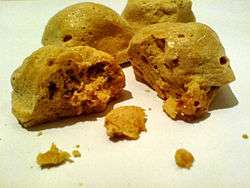Honeycomb toffee
 | |
| Alternative names | Sponge toffee, cinder toffee, golden crunchers, hokey pokey |
|---|---|
| Type | Toffee |
| Main ingredients | Brown sugar, corn syrup (or molasses or golden syrup), baking soda |
|
| |
Honeycomb toffee, sponge toffee or cinder toffee is a sugary toffee with a light, rigid, sponge-like texture. Its main ingredients are typically brown sugar, corn syrup (or molasses or golden syrup in the Commonwealth) and baking soda, sometimes with an acid such as vinegar. The baking soda and acid react to form carbon dioxide which is trapped in the highly viscous mixture. When acid is not used, thermal decomposition of the baking soda releases carbon dioxide. The lattice structure is formed while the sugar is liquid, then the toffee sets hard.
In some regions it is often made at home, and a popular recipe for children. It is also made commercially and sold in small blocks, or covered in chocolate, popular examples being the Crunchie or Violet Crumble bar.
Regional names
Honeycomb toffee is known by a wide variety of names including:
- cinder toffee in Britain[1] "Cinder toffee" is also used to refer to brittle treacle toffee. Yellowman in Northern Ireland is very similar to honeycomb toffee.
- fairy food candy or angel food candy in Wisconsin, USA[2]
- hokey pokey in New Zealand[3][4][5][6] (especially in the Kiwi classic Hokey Pokey ice cream).
- honeycomb in South Africa, Australia and Britain[7]
- puff candy in Scotland[8]
- sea foam in Maine, Washington, Oregon, Utah, California and Michigan, USA
- sponge candy in Milwaukee, Wisconsin, St. Paul, Minnesota, Western New York, and Northwest Pennsylvania, USA[9]
- sponge toffee ("tire éponge") in Canada[10]
- old fashioned puff in Massachusetts[11]
- oritaegi(오리때기) in South Korea : usually made out of white sugar.

In various cultures
The same confection is a traditional sweet in Japan known as karumeyaki (カルメ焼き), from the Portuguese caramelo & the Japanese yaki (to bake). It is typically hand-made, and often sold by street vendors. In Hungary, it is known as törökméz (Turkish honey) and commonly sold at town fairs. In Korea, Bbopgi (뽑기,달고나) is a very similar sugar candy.
In South Korea, it is called Oritaegi. It was a popular confection for children in the eighties and children usually made it for themselves at the street vendors' that were equipped with the briquettes. They paid for white sugar and baking soda and using the briquette but the fashion didn't last long and at present time, it's rightly said it has disappeared.
References
- ↑ Connelly, Andy (2010-09-24). "The science and magic of cinder toffee | Andy Connelly | Science | guardian.co.uk". Guardian. Retrieved 2012-01-05.
- ↑ "Two local chocolate makers battle over use of 'fairy food'". JSOnline.com. December 22, 2011. Retrieved 6 December 2013.
- ↑ "Papers Past — Evening Post — 19 December 1927 — THE TRUANT STAR". Paperspast.natlib.govt.nz. 1927-12-19. Retrieved 2012-01-05.
- ↑ Chelsea's team of cooks, added 25 May 2011 (2011-05-25). "Chelsea Sugar - Hokey Pokey". Chelsea.co.nz. Retrieved 2012-01-05.
- ↑ "Hokey Pokey - New Zealand Kids Recipe at KiwiWise". Kiwiwise.co.nz. Retrieved 2012-01-05.
- ↑ "Popular Kiwi recipes – pavlova, anzac biscuits, roast lamb, pikelets etc". Kiwianatown.co.nz. Retrieved 2012-01-05.
- ↑ "Food - Honeycomb recipes". BBC. Retrieved 2012-01-05.
- ↑ S.W.R.I. (1977). S.W.R.I. Jubilee Cookery Book. Edinburgh: Scottish Women's Rural Institutes; Reprint of 8th Edition (1968), p179
- ↑ "Sponge Candy: Chocolate, With a Center of Honeycomb". BuffaloChow.com. January 1, 2008. Retrieved 13 January 2010.
- ↑ "Sponge Toffee Recipe". CanadianLiving.com. Fall 2009. Retrieved 6 arch 2014. Check date values in:
|access-date=(help) - ↑ "Hill Top Candy". hilltop candy.com. 2015. Retrieved 6 arch 2014. Check date values in:
|access-date=(help)
| ||||||||||